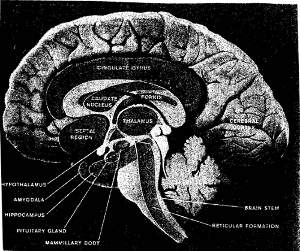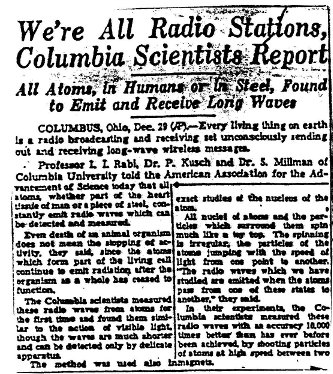Excerpt and four illustrations from Background article:Cold War physics in neuroscience is now revealing the probability of a successfully weaponized brain by Cheryl Welsh, May 2013. Click here for full background article.A hypothetical conversation on neuroweapons between a famous skeleton and a skull called Yorick. Question: "What facts are hidden in plain sight?" Answer: "When you find the missing biophysics, you find a weaponized brain nearby."  Book cover; On the Structure of the Human Body , Andreas Vesalius (1514-1564) Book cover; On the Structure of the Human Body , Andreas Vesalius (1514-1564)

|
Classified Neuroscience researchBiophysics, Bioelectronics In 1954, George Beadle, Nobel laureate and member of the Atomic Energy Commission advisory committee on biology and medicine, warned: Like many others, I see in our present security system a machine so complex in its operation that, once having been set in motion, it is almost impossible either to control or to stop. And I sense a real danger that it may destroy our way of life if we do not find a way to control it. (Who wrote the book of life? Kay, 2000, p.132). |
 Side view of one half of the human brain Side view of one half of the human brain |
Unclassified Neuroscience researchMolecular Biology, Biochemistry In 2012, there were 40,000 members of American Society for Neuroscience with “massive representation of molecular biology, cognitive psychology and brain imaging.” (The good, the true and the beautiful, Changeux, 2012, p.317). Molecular biology is now expected to take the dominant role in the twenty-first century that physics played in the twentieth. (Design for life, DeChadarevian, 2002, p.1). |
 December 29, 1939 New York Post, “We're All Radio Stations, Columbia Scientists Reports, All Atoms, in Humans or in Steel, Found to Emit and Receive Long Waves."
December 29, 1939 New York Post, “We're All Radio Stations, Columbia Scientists Reports, All Atoms, in Humans or in Steel, Found to Emit and Receive Long Waves."First two sentences from December 29, 1939 New York Post, “We're All Radio Stations, Columbia Scientists Reports, All Atoms, in Humans or in Steel, Found to Emit and Receive Long Waves."
Columbus, Ohio, Dec. 29 (AP). Every living thing on earth is a radio broadcasting and receiving set unconsciously sending out and receiving long-wave wireless messages.
Professor I. I. Rabi, Dr. P. Kusch and Dr. S. Millman of Columbia University told the American Association for the Advancement of Science today that all atoms, whether part of the heart tissue of man or a piece of steel, constantly emit radio waves which can be detected and measured.
The US atomic bomb exploded and the world discovered the existence of a formidable secret weapon. By contrast, Cold War mind control weapons that target the brain, today known as neuroweapons, are another formidable weapon whose power lies in their surreptitious use and keeping them secret forever. Physics dominated the first half of the twentieth century. Cold War mind control weapons, now called neuroweapons, the atomic bomb, microwave radar, and signals intelligence were all being developed in secret research requiring physics which overlapped with the physics and technologies required to study the brain. In the unclassified research world, neuroscientists have focused mainly on molecular biology and biochemistry, not physics and bioelectricity. Even Obama’s proposed brain mapping project is completely focused on molecular biology. How did this happen? Molecular biology and biophysics were taking off in the 1950s but the biophysics bubble bursts in the 1960s. (Rasmussen, The midcentury biophysics bubble: Hiroshima and the biological revolution in America, revisited", History of Science 35: 245, 1997). It is a fascinating obscure history.
The history of bioelectricity in neuroscience is about extreme controversy and limits
In the twentieth century, the neuron doctrine was a guiding principle of brain research; that the brain cell called the neuron is the primary functional signaling unit of the brain and connects with other neurons. This is also the principle behind the so-called connectionist model. In the 1950s, Hodgkin, Huxley and Eccles formulated the ionic hypothesis and they were awarded the 1963 Nobel Prize for this discovery. The hypothesis states that the action potential of the neuron is the ionic current of potassium, sodium and chloride ions passing through pores in the neuron’s membrane. (Neuroscience, Kandel, Science, 10 Nov. 2000). In 1953, Eccles published the influential book The neurophysiological basis of mind: The principles of neurophysiology, which “laid out the future of cellular and circuit neuroscience.” (Gordon, p. 94). Around the world, “studies of the synaptic organization of the neuron” and its pathways took off and this area of research has remained dominant. The neuron doctrine is fundamental to modern neuroscience although without expanding its principles, it is considered incomplete and too simplistic to explain how brain biology is related to human behavior. Neuroscientists have confined their physics research methods to neuron action potentials. Regarding the electricity of the brain; little else is accepted as valid in mainstream neuroscience today.
Also in the 1950s, in order to understand the mechanisms of heredity, a race to reveal the chemical structure of DNA took place in labs around the world. (Gordon, p. 19). Watson and Crick won the DNA race and the Nobel Prize. Eccles and much of neuroscience joined the new molecular biology and biochemistry approach to the study of the brain which would completely overshadowed the dominant biophysics approach of Eccles and others at the time. This was in part due to the increasing use of the electron microscope and arguably, because so much of physics research was classified. Biophyics was absorbed by molecular biology which culminated in the Human Genome Project, as well as by biochemistry and modern neuroscience. Molecular biology is one major area of science that has dominated neuroscience research. (Squire, Fundamental Neuroscience, Fourth edition, 2013, p. 9)
Technologies to access the brain provide further clues of secret neuroweapons
It becomes relevant that today, unclassified neuroscience lacks technologies that can access the brain remotely although such tools are based on well-known physics principles. Even Obama’s Brain Mapping Project is focused on molecular biology and does not include plans for technologies to access the brain remotely, in spite of the preference for noninvasive remote methods. For example, invasive surgeries performed on healthy human subjects in experiments are unethical. I. I. Rabi, cited above in the "radio receivers newspaper article, won the 1944 Nobel Prize in physics for his resonance method or radiofrequency spectroscopy. Rabi was one of nine scientists--mostly physicists—who played a role in the development of the MRI, a machine that can scan the brain at a distance, although with huge magnets nearby.
Conclusions
The limited physics research in neuroscience is striking in light of the fact that brain electricity is one of two major areas of study essential to understanding the electrochemical brain. Even a basic understanding of the brain’s electrical system requires much more than the limited study of neuroscience today with its focus on the neuron doctrine, ionic currents and action potentials, and the connectionist model. Also relevant, in unclassified neuroscience research, non-remote technologies to access the brain have been limited to the brain implant, the EEG and scanning machines such as the MRI. Physics of the brain requires the study how the brain conveys and integrates information that results in human behavior; it requires the study of interactions of electricity, magnetism and electromagnetism in the brain, including in individual brain cells and groups and systems of cells. It requires measuring and studying how the brain communicates via direct currents, semiconducting electricity and EMR and magnetic waves of the brain. The importance of biophysics to the study of the brain was well known in the 1950s; nevertheless, for over half a century, neuroscience has completely ignored this area of physics. In particular, the brain as an electrical system has been scientifically established although not definitively proven or accepted in mainstream neuroscience.
It sounds absolutely impossible. How could so many have been misguided by neuroscience and the physics of neuroweapons for so long? As the saying goes, "If the only tool you have is a hammer, you will see every problem as a nail." Likewise, since the 1950s, prominent experts have overlooked obscure but critical information and thus have remained absolutely convinced that the science of mind control is science fiction. Today this unwavering consensus remains firmly in place. However the converging facts support that the science of neuroweapons has been possible since the 1950s. For these reasons, secret US neuroweapons are more likely than not successfully developed. Further research and investigation is called for.
Contents | Top